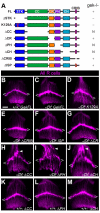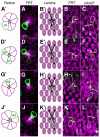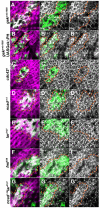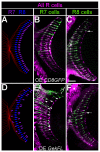The cytoskeletal regulator Genghis khan is required for columnar target specificity in the Drosophila visual system
- PMID: 22007130
- PMCID: PMC3201660
- DOI: 10.1242/dev.069930
The cytoskeletal regulator Genghis khan is required for columnar target specificity in the Drosophila visual system
Abstract
A defining characteristic of neuronal cell type is the growth of axons and dendrites into specific layers and columns of the brain. Although differences in cell surface receptors and adhesion molecules are known to cause differences in synaptic specificity, differences in downstream signaling mechanisms that determine cell type-appropriate targeting patterns are unknown. Using a forward genetic screen in Drosophila, we identify the GTPase effector Genghis khan (Gek) as playing a crucial role in the ability of a subset of photoreceptor (R cell) axons to innervate appropriate target columns. In particular, single-cell mosaic analyses demonstrate that R cell growth cones lacking Gek function grow to the appropriate ganglion, but frequently fail to innervate the correct target column. Further studies reveal that R cell axons lacking the activity of the small GTPase Cdc42 display similar defects, providing evidence that these proteins regulate a common set of processes. Gek is expressed in all R cells, and a detailed structure-function analysis reveals a set of regulatory domains with activities that restrict Gek function to the growth cone. Although Gek does not normally regulate layer-specific targeting, ectopic expression of Gek is sufficient to alter the targeting choices made by another R cell type, the targeting of which is normally Gek independent. Thus, specific regulation of cytoskeletal responses to targeting cues is necessary for cell type-appropriate synaptic specificity.
Figures









References
-
- Brand A. H., Perrimon N. (1993). Targeted gene expression as a means of altering cell fates and generating dominant phenotypes. Development 118, 401–415 - PubMed
-
- Chen X. Q., Tan I., Leung T., Lim L. (1999). The myotonic dystrophy kinase-related Cdc42-binding kinase is involved in the regulation of neurite outgrowth in PC12 cells. J. Biol. Chem. 274, 19901–19905 - PubMed
Publication types
MeSH terms
Substances
Grants and funding
LinkOut - more resources
Full Text Sources
Molecular Biology Databases
Miscellaneous

